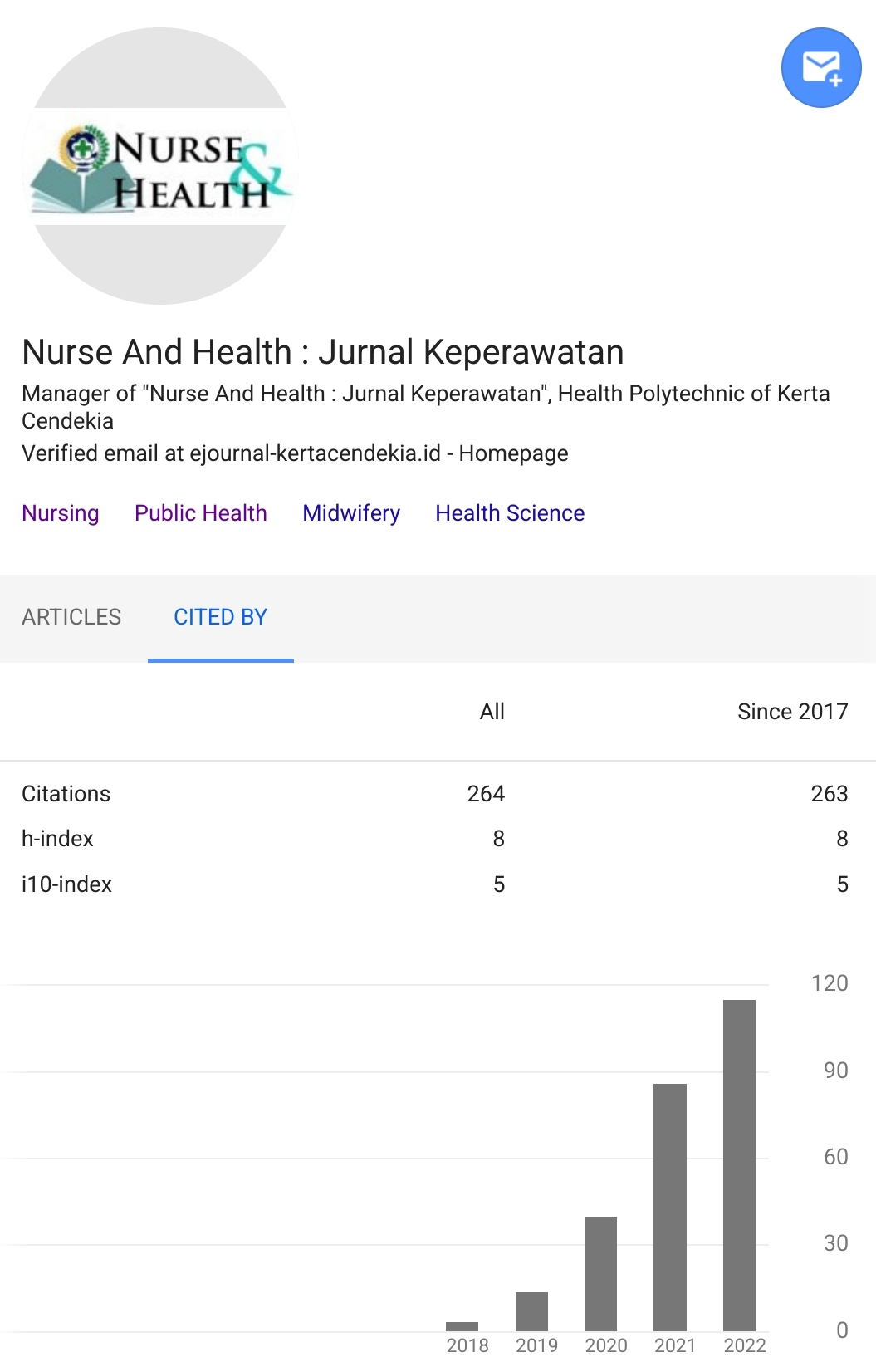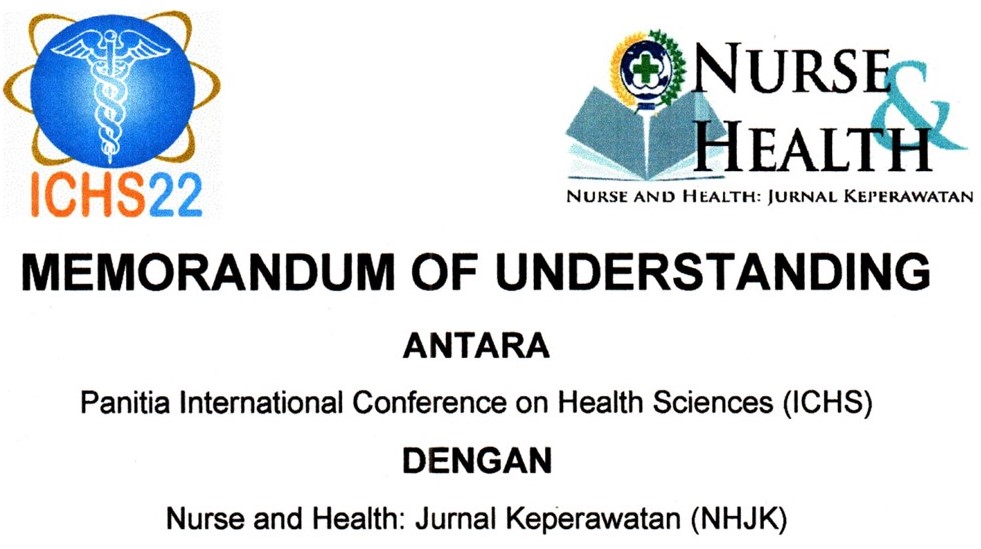THE EFFECT OF WARM GINGER COMPRESS TOWARDS JOINT PAIN OF THE ELDERLY AT UPT PANTI WERDHA MOJOPAHIT, MOJOKERTO DISTRICT
Abstract
Background: There was joint pain that frequently happens by the elderly, which was joint pain. One of actions to abate the joint pain was compress with warm ginger.Objectives: The aims of this research were to identify the effect of warm ginger compress towards joint pain of the elderly at UPT Panti Werdha Mojopahit, Mojokerto District.Method: Design of this research was Pre-Experiment with Type of one group pre-test-post test design. Population of this research was whole of elderly who undergoes joint pain at UPT Panti Werdha Mojopahit Mojokerto district. Technique that used to take sample in this research was purposive sampling with 20 respondents. Data collecting was done before and after warm ginger compress was given use pain scale instrument PAINAD with 1-10 scale. The researcher used Wilcoxon statistic test with value of α=0, 05 to analyze the data.Results: The result of this research wasgained before carried out by warm ginger compress with advance pain scale of 6 respondents (30%), and intermediate pain scale of 10 respondents (50%). After the warm ginger compress was done by 8 respondents (40%) with light pain scale and 11 respondents (55%) with intermediate pain. Data analyzing used statistic test with Wilcoxon P value test 0,003 (α˂ 0, 05). It showed that warm ginger compress effective towards joint pain of the elderly.Conclusion: Looking at the result above shows that warm ginger compress can be created as one of alternative choices to decrease joint pain intensity of the elderly, because this non-pharmacologist treatment uses easy to be obtained ingredient and there is no side effect for the elderly.Key words: Joint Pain, Warm Ginger Compress, Elderly.Downloads
References
Arikunto, S. (2010). 206. Prosedur Penelitian Suatu Pendekatan Praktik. Jakarta: PT Rineka Cipta.
Azizah, L. M. R. (2011). Keperawatan Lanjut Usia. Yogyakarta: Graha Ilmu.
Brunner & Suddarth. (2013). Keperawatan Medikal Bedah. Jakarta: EGC.
Corwin, E. J. (2000). Buku Saku Patofisiologi. Jakarta: Buku Kedokteran EGC.
Damaiyanti, S., & Siska, T. Y. (2014). Pengaruh Kompres Jahe Hangat Terhadap Penurunan Intensitas Nyeri Artritis Rhematoid Pada Lanjut Usia Di Panti Sosial Tresna Werdha Kasih Sayang Ibu Kanagarian Cubadak Batu Sangkar 2012. 'AFIYAH, 1(2).
Fauzi, Arif. (2017). Aneka Tanaman Obat dan Khasiatnya. Yogyakarta: Media Pressindo.
Hamid, A. Y. S. (2007). Riset Keperawatan: Konsep, Etika dan Instrumentasi. Jakarta: EGC.
Heriana, Arif. (2009). Tumbuhan Obat dan Khasiatnya. Seri I. Jakarta: Penebar Swadaya.
Hidayat, A., Aziz. (2012). Pengantar Kebutuhan Dasar Manusia – Aplikasi Konsep dan Proses Keperawatan, Edisi 2. Jakarta: Salemba Medika.
Izza, S. (2014). Perbedaan Efektifitas Pemberian Kompres Air Hangat dan Pemberian Kompres Jahe Terhadap Penurunan Nyeri Sendi pada Lansia di Unit Rehabilitasi Sosial Wening Wardoyo Ungaran. Skripsi: STIKES Ngudi Waluyo Ungaran.
Mansjoer, A. (2000). Kapita Selekta Kedokteran. Jakarta: Media Aesculapius.
Mubarak, W. I., Indrawati, L., & Susanto, J. (2015). Buku Ajar Ilmu Keperawatan Dasar. Jakarta: Salemba Medika.
Mujahidullah, K. (2012). Keperawatan Geriatrik. Yogyakarta: Pustaka Pelajar.
Notoatmodjo, S. (2010). Metodologi Penelitian Kesehatan. Jakarta: Rineka Cipta.
Nugroho, H. Wahyudi. (2000). Keperawatan Gerontik 2 Geriatrik Edisi 3. Jakarta: EGC.
Nursalam. (2016). Metodologi Penelitian Ilmu Keperawatan : Pendekatan Praktis. Jakarta: Salemba Medika.
Perry, A. G., & Potter, P. A. (2005). Buku Ajar Fundamental Keperawatan: Konsep, Proses Dan Praktik. Jakarta: EGC.
Pudjiastuti, S. S., & Utomo, B. (2003). Fisioterapi Pada Lansia. Jakarta: EGC.
Stanley, M., & Beare, P. G. (2006). Buku Ajar Keperawatan Gerontik. Jakarta: EGC.
Sunaryo, W. Rahayu. (2016). Asuhan Keperawatan Gerontik. Yogyakarta: ANDI.
Utami, dkk. (2005). Tanaman Obat untuk Mengatasi Nyeri Rematik dan Asam Urat. Jakarta: ECG.
Authors who publish with Nurse and Health: Jurnal Keperawatan agree to the following terms:
- Authors retain copyright licensed under a Creative Commons Attribution-NonCommercial 4.0 (CC BY-NC 4.0), which allows others to remix, tweak, and build upon the authors' work non-commercially, and although the others' new works must also acknowledge the authors and be non-commercial, they don't have to license their derivative works on the same terms.
- Authors are permitted and encouraged to post their work online (e.g., in institutional repositories or on their website) prior to and during the submission process, as it can lead to productive exchanges, as well as earlier and greater citation of published work (See The Effect of Open Access). Authors can archive pre-print and post-print or publisher's version/PDF.






















